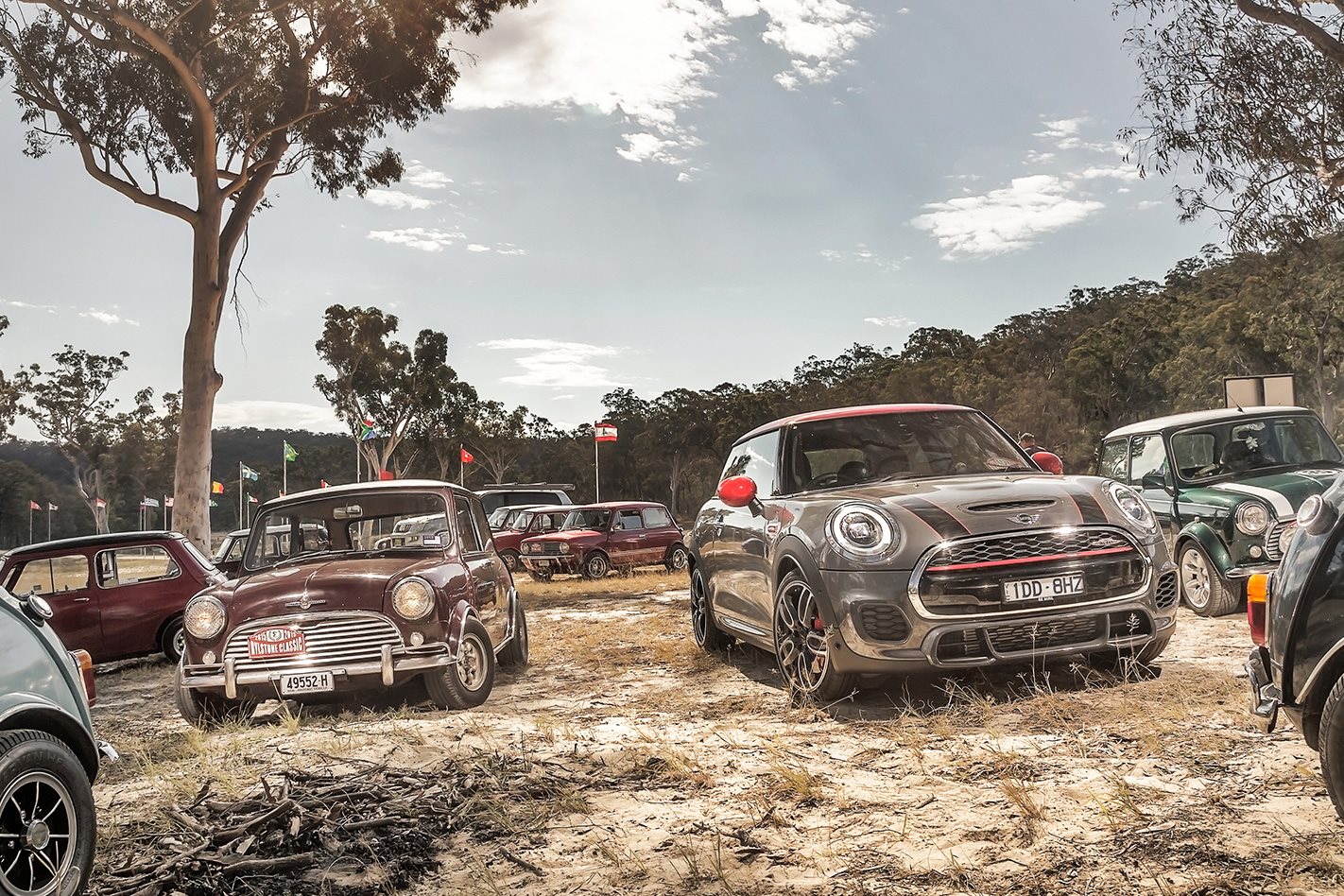Alec Issigonis wouldn’t have approved of today’s frivolities. The original Mini designer/engineer obsessed over designing a British people’s car.
He moved the wheels to each corner, utilised then-unpopular front-wheel drive and laid the engine an unheard-of east-west, stuffing the gearbox and diff inside the sump to provide sedan-beating interior space within a 3.05-metre length.
His engineering background also meant creating independent suspension in the name of roadholding that was unflippable for mothers going to the market.
It took racing friend John Cooper to nudge him on the arm and tell him he’d inadvertently created a sporty car, but pragmatist Issigonis laughed. So JC built one and took it to BMC management, who signed off on the Cooper S project.
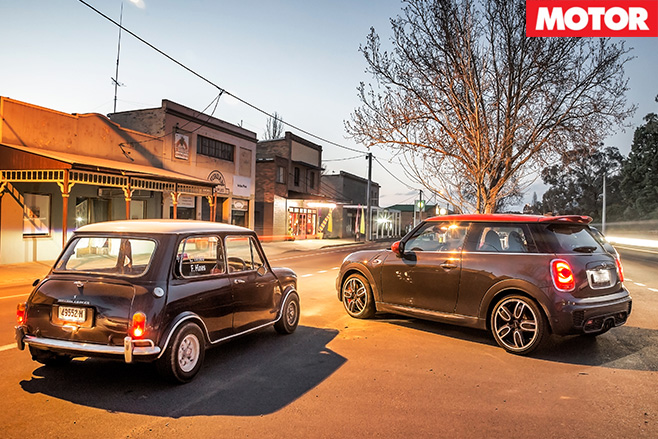
The arrival of today’s new John Cooper Works and its title as the fastest MINI ever makes it a timely entrant in the fifth annual Rylstone Classic – a ‘pretend rally’ celebration between 60 original Mini owners.
Pretend rally? We’re told that this 500km-long punt across some of New South Wales’ best driving roads will be no mothers-to-market meander.
The startline is on the northern outskirts of Sydney, where the Pie in the Sky eatery’s car park is packed with cars and contenders, including a couple wearing free-love colour tees. It feels like the swinging 60s.
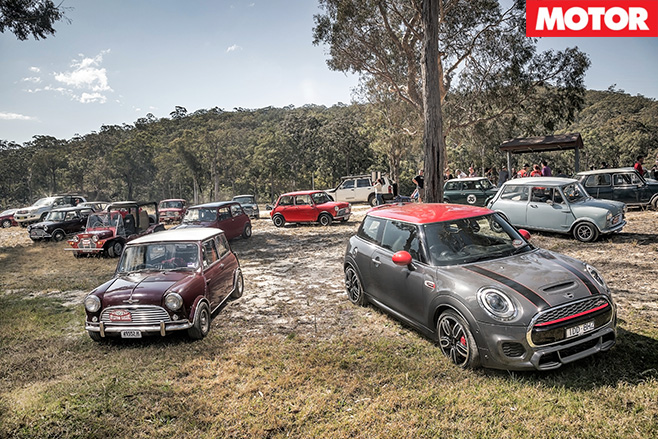
There are some lovely original Minis here, though, that all smell of innocence. Little details, such as wire mesh over the headlights and extruded door latches, define class. But even discussing image is hardly the point of today – more importantly, would John Cooper be proud of the new MINI that bears his name?
Only kilometres after the start-line, any sign of the original’s cuteness evaporates. Tracing the uphill start of Putty Road – a 174km stretch of twisty tarmac – a sweet pale-blue Cooper S is working hard to point its little nose towards the matching blue sky.
As the blacktop crests then unrolls like a wide tarmac cable, the slithering corners ahead become a spectacle, like watching Nanna’s old bathtub bobbing like a sled on a downhill course. The tiny 10.0-inch tyres squirm on the oil-filled Hydrolastic suspension, yet its cornering stance remains tidy.
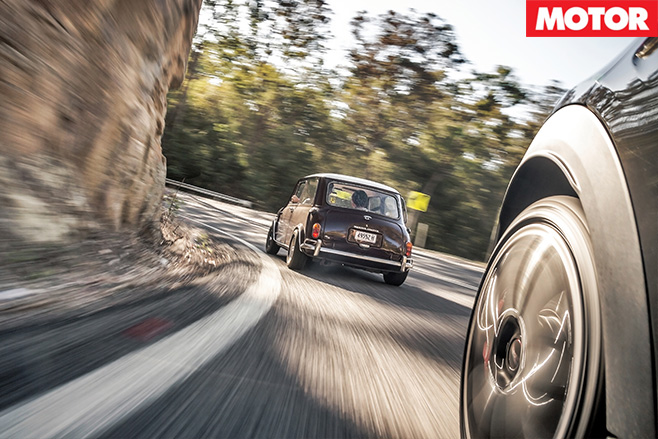
A glance in the JCW’s electro-chromatic rear-view mirror suddenly reveals a matte-black Mini following behind. It makes me feel eerily uncomfortable, the yellow-glow halogen headlights appearing slightly evil, as though it is a giant-killer from Mad Max. An overtaking lane emerges and behind ‘Darth Mini’ suddenly splays a Skittles-coloured Mini-posse on the chase.
We drop windows and the angry blurt of 1275 furious cubic centimetres screams past backed by a flurry of pops and crackles. Our MINI’s left paddle gets slapped twice as the accelerator is flattened but there is only a distant baritone boom. “Yeah,” photographer Wielecki pauses, poker faced. “Darth sounds better.”
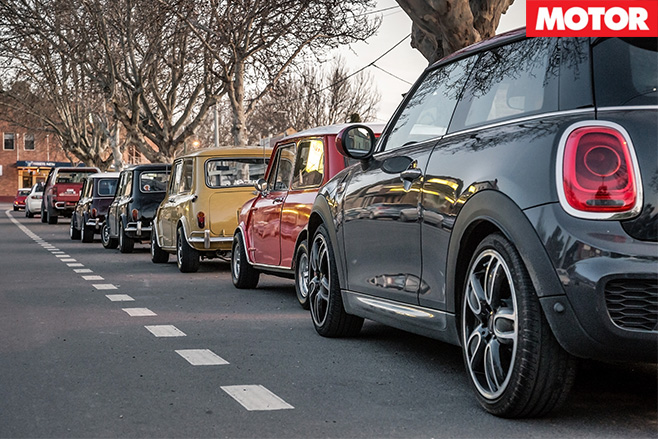
A stats comparison is interesting: the 1275 S left the Sydney factory with 57kW and 107Nm pushing the 676kg brick to 100km/h in 10.8 seconds.
Our Cooper JCW has two extra gears (six-speed auto, sadly no manual is available yet) with not quite double the capacity (2.0-litre) producing, thanks to a turbocharger, almost exactly three times the outputs – 170kW and 320Nm. With nearly double the mass to shift (1220kg), however, the new car’s 6.1-second 0-100km/h sprint isn’t half as fast as the original.
Meanwhile the overtaking lane ends as a long straight appears. Ahead we see the pale-blue Mini settling begrudgingly at the speed limit behind a gathering of sports bikes. Or at least that’s our assumption until a whiff of smoke signals an imminent overtake on a road surface that looks like a picnic rug thrown over unmown grass. Bouncing and bobbing away, pale-blue is gone after a few kilometres.
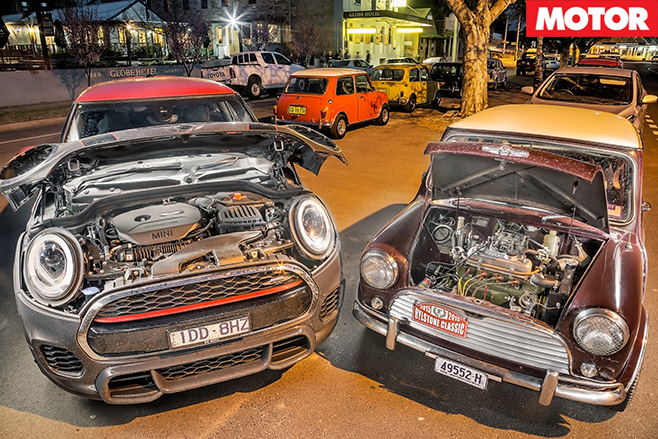
“Well… kinda,” he starts. “The engine’s bored and stroked to about 1330cc and I’ve shortened the throttle body for better low-end torque and…”
The talking soon turns to fuel stops, with some Minis having a single 20-litre tank positioned on the left side of the boot. Twin-tank models – standard on Cooper S – encroach boot space by having another 20 litres on the right, and can be identified by a second fuel cap on that side’s rear haunch.
While pies are being downed, we get a head start with father-and-son duo Frank and Luke Hines kindly giving us a drive in their restored 1966 Cooper S.
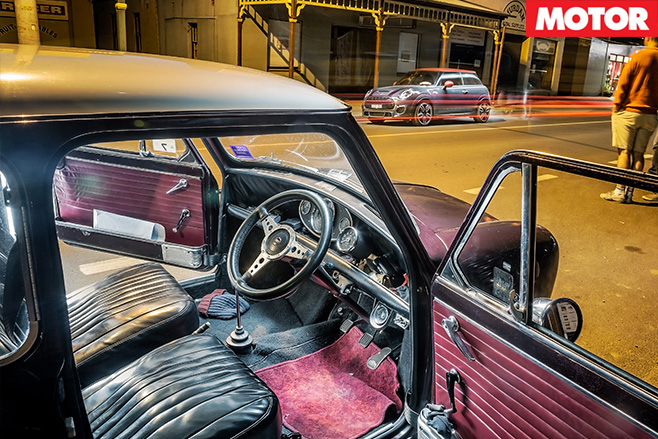
The JCW’s driving position and broad dash feel comparatively SUV-like. In our new model a plastic rocker switch on the lower dash acts as the engine start button; in the old S you switch the fuel pump on by flicking an actual metal rocker switch before twisting the key.
Within two metres the 1275 S feels twice as frenetic as the JCW. Steering systems are often tagged as sharp, but this description would downplay how wonderfully electric the original’s rack-and-pinion system is. Move millimetres off centre and it seems to confuse your desire for turning into a mere bend with wanting to punt into a switchback.
Accelerating sounds as though your ear is attached to the throttle-body – it sits just behind the speedo – so 5000rpm feels like 7000rpm, and in Frank’s car the straight-cut four-speed manual mimms and ehhhs loudly with each upchange.
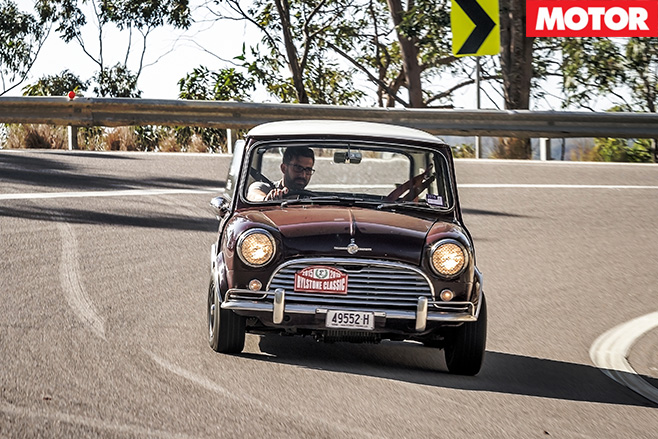
Meanwhile the unassisted brakes require the firmest of presses, yet the throttle is high enough to force ballet-style en pointe footwork when attempting to rev-match – it’s stand on middle pedal with toe, just reach right one with back of heel. Unfortunately you’re left looking more like a dad dancer at the local RSL, the completely flat seat slamming you against the door in corners while you desperately cling to the hyper-active tiller for support.
Similarities between the two Mini Cooper models are apparent, particularly on corner exit. Each keep their bodies flat at the front end, working those wheels hard before allowing a surprisingly early squeeze of the throttle. There’s gentle understeer, but ultimately a fast and neat exit. Compared with the lairy behaviour of 60s muscle cars, it’s easy to see why this earliest iteration of hot-hatch was celebrated.
At the northern tip of Putty, we switch back on Bylong Valley Way that forks over the other side of the Blue Mountains and threads to the Rylstone finish line, not far from Bathurst. With dusk photography required, we wave goodbye to Frank and Luke.
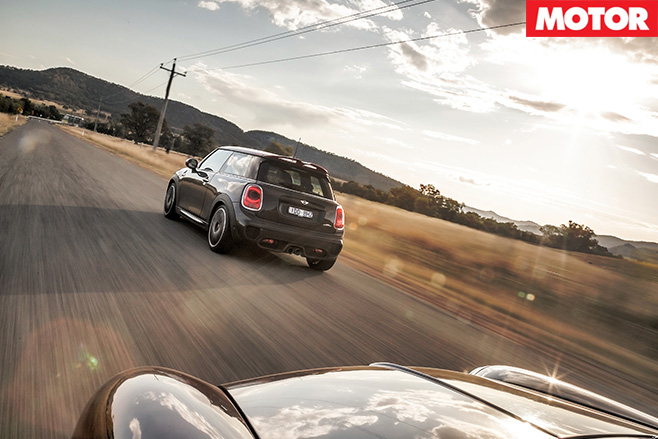
Despite that fun this latest MINI’s behaviour is utterly polished; JCW specials are typically more of a riot. The steering ultimately lacks the immediacy of its predecessor, let alone the electricity of the 1275 S, and the chassis is so balanced it stays planted even following a mid-corner brake brush. As a racing driver, John Cooper would probably adore it and punch me in the face – their kind loved grip and go.
Even then, perhaps MINI isn’t trying when it comes to ‘go’, because the same 2.0-litre in a BMW 330i makes another 50Nm (and Audi’s S1 produces 370Nm). If there’s a message from today, it’s that extracting everything out of a car reaps the greatest rewards. As likeable as it is, this JCW feels like it has more to give.
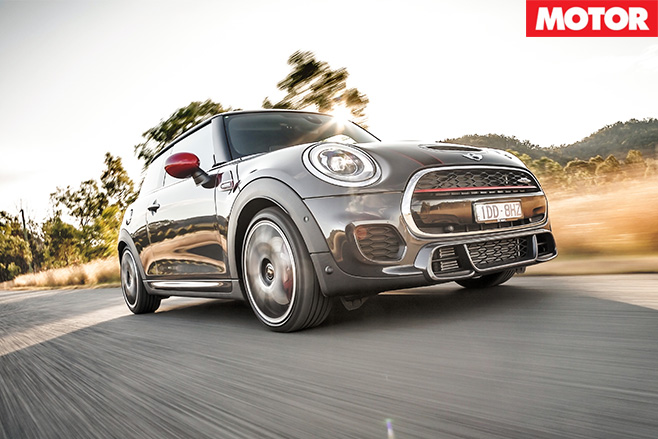
After 500km already, it’s active cruise control on, head-up display pointing sat-nav directions and LED headlights blazing. Turbo torque swells as the auto relaxes in sixth, Wielecki snoozes in the broad passenger seat and I gently crank up the Harman Kardon stereo that – much like the car itself – is anything but mini.
3.5 OUT OF 5 STARS
SPECS: MINI COOPER S JCW Body: 3-door, 4-seat hatch Drive: front-wheel Engine: 1998cc inline-4, DOHC, 16v, turbocharger Bore/stroke: 82.0 x 94.6mm Compression: 10.2:1 Power: 170kW @ 5200-6000rpm Torque: 320Nm @ 1250-4800rpm Power/weight: 139kW/tonne Transmission 6-speed auto Weight: 1220kg Suspension (f): struts, coil springs, dampers, anti-roll bar Suspension (r): multi-links, adaptive dampers, anti-roll bar L/W/H: 3874/1727/1414mm Wheelbase: 2495mm Tracks: 1485mm (f/r) Steering: electrically-assisted rack-and-pinion Brakes (F): 330mm ventilated discs, 4-piston calipers Brakes (R): TBC Wheels: 18.0 x 7.0-inch (f/r) Tyre sizes: 205/40 R18 (f/r) Tyre: Pirelli Cinturato P7 (f/r) Price as tested: $49,950 (auto) Pros: Lotsa grunt; new-found civility; looks Cons: Softer than predecessors; price
Minis en masse
Doing a bit of car spotting
A big thanks to ausmini.com and organiser Evan Redman for allowing MOTOR to bring the newbie along on the well-organised drive. Closing the generation gap just like Frank and Luke, he steered a Cooper S alongside his old man.
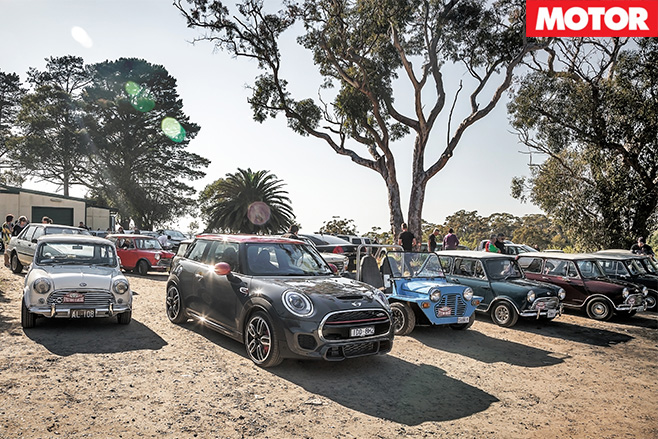
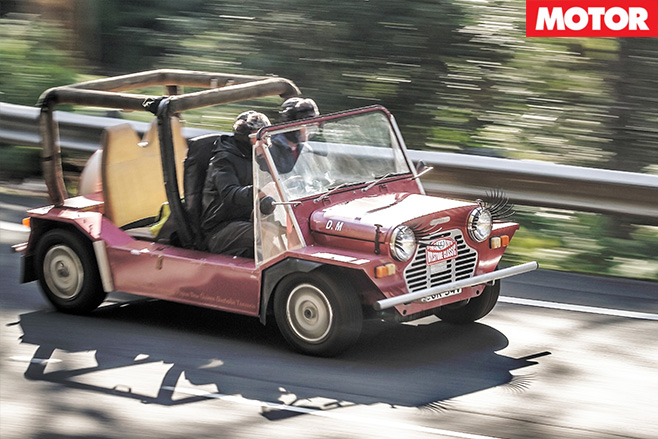
Biggest Mini fans had to be Peter and Karen Morris, who have 42 Minis in Victoria but chose to drive only one to Sydney. It broke down halfway and forced them to overnight it in the Mini’s pews. They made it, however, and completed the rally. That’s the spirit!

